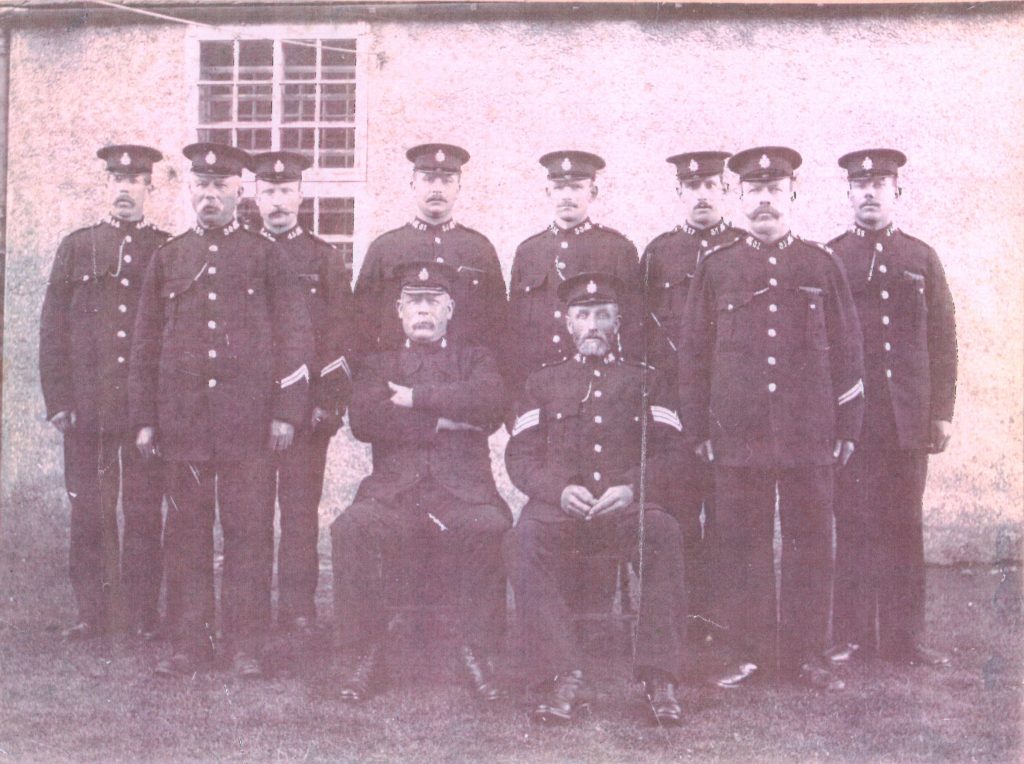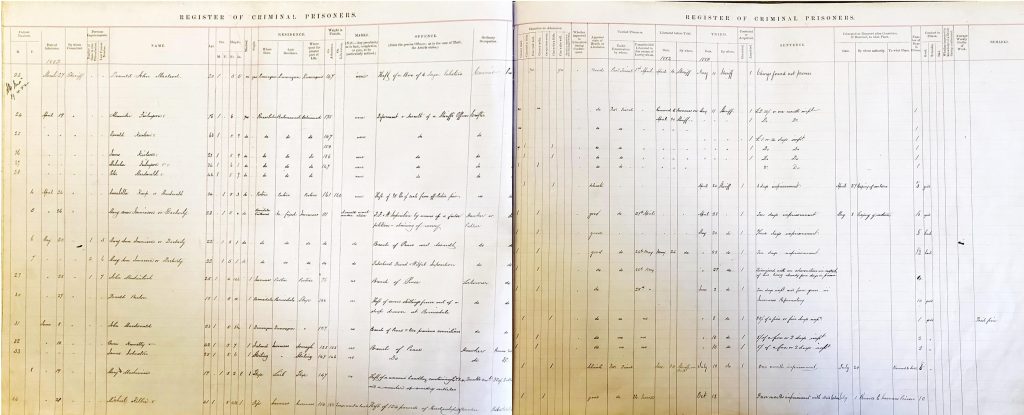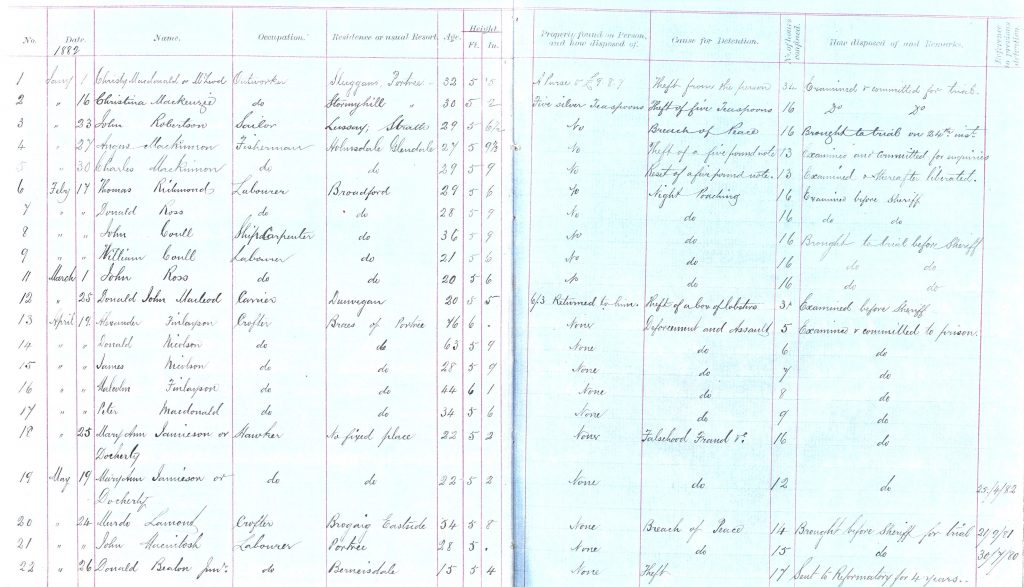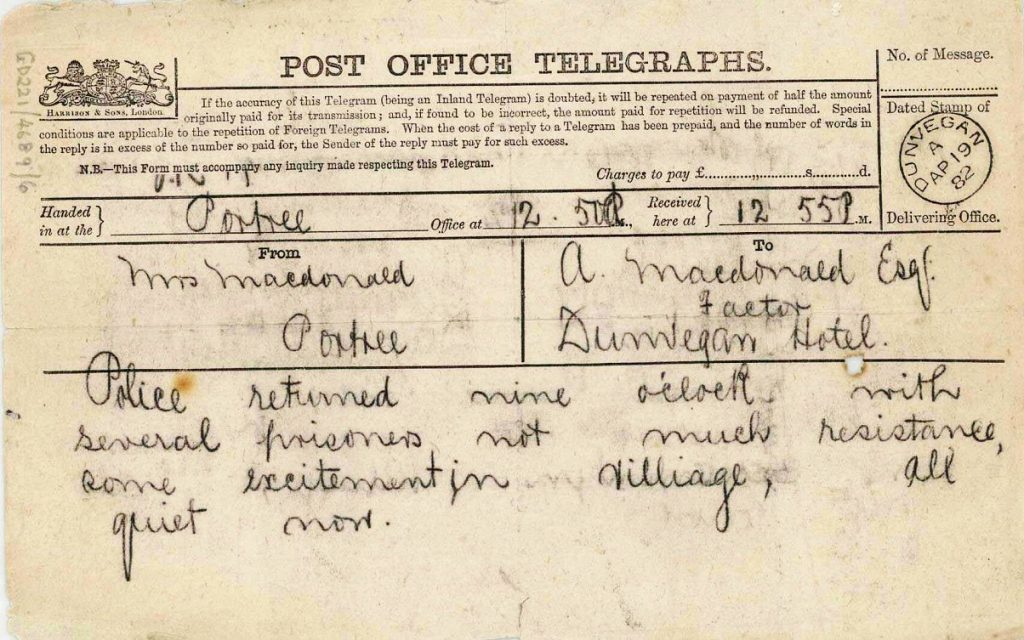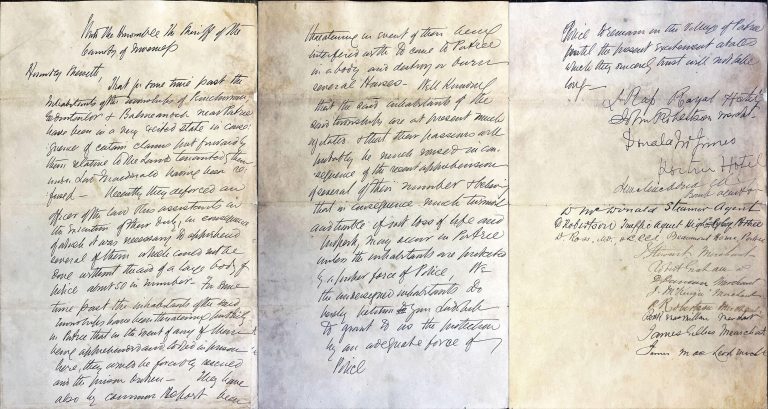After gathering themselves together on arrival at Portree, the expeditionary force of two sheriffs, one police superintendent, nine Inverness-shire constables and forty seven Glasgow constables marched on Braes to arrest the five crofters for deforcement.
The early morning arrival of the authorities took the people of Braes by surprise and the five ringleaders, Alexander Finlayson, Malcolm Finlayson, Peter MacDonald, Donald Nicolson and James Nicolson, were arrested. They were to be taken to Portree prison before being sent to Inverness for trial. The arrests themselves were not disputed but objections to the men being removed from the island and sent to Inverness led to an immediate riot.
As word spread the Braes people mobilised and the officers soon faced a hostile mob as they negotiated their return journey to Portree through the small crofting township of Gedintailor. On their journey out of Braes through a narrow gorge and crossing of the burn, Allt nan Gobhlag, an angry crowd gathered, and the Battle took place.
Violence soon broke out. According to David Gow of the Dundee Advertiser, the women in the crowd declared that the police must be attacked. In response the police drew their batons and charged the crowd and the riot erupted. Gow wrote:
“Huge boulders darkened the horizon as they sped from the hands of the infuriated men and women. Large sticks and flails were brandished and brought down with crushing force upon the police. Many were struck and a number more or less injured.”
The police baton charged the crowd twice but the crofters were undeterred and the stones kept flying.
The Police sped up their retreat but at An Cumhang they encountered further resistance from more angry crofters. A determined baton charge allowed the police to break through the mob and, in a state of some disorder, they retreated to the comparative safety of Portree with the five arrested men in tow. As they made their way through the town to the prison, they were hissed at by bystanders.
It wasn’t just the police who sustained significant injury at the Battle of the Braes. Accounts from other reporters noted how the women of Braes were as involved as the men in the Battle, suffering physical injuries also.
The Reaction
The reaction of those not directly involved in the events at Braes on the 19th of April 1882 was mixed. Mrs MacDonald, wife of Alexander MacDonald, factor for Lord Macdonald’s estate, sent a telegram to her husband on the evening of the Battle suggesting everything had returned to normal.
“Police returned nine o’clock with several prisoners not much resistance, some excitement in village, all quiet now”
Other residents in Portree felt the resistance had not died down and the day after the Battle they requested additional police be sent to the village to keep them safe from the angry crofters.
Excerpt from above document:
‘For some time past the inhabitants of the said townships [Penichorran, Gedintailor and Balmeanoch] have been threating publicly in Portree that in the event of any of them being apprehended and locked in prison here, they would be forcibly rescued, and the prison broken. They have also by common report been threatening in event of them being interfered with to come to Portree in a body and destroy or burn several houses.’
‘Well knowing that the said inhabitants of the said township are at present much agitated and that their passions will probably be much aroused in consequence of the recent apprehension of several of their number and believing that in consequence much turmoil and trouble if not loss of life and property, may occur in Portree unless the inhabitants are protested and a further force of Police.’
Signed by: L. Ross Royal Hotel, John Robertson (Merchant), Donald MacInnes (Portree Hotel), Alexander MacDonald (Bank Agent), D. McDonald (Steamer Agent), D. Robertson (Traffic Agent), D. Ross (Beaumont House), J. Stewart (Merchant), Robert Graham, D. Duncan (Merchant), K. MacKenzie (Merchant), James MacLeod (Merchant), R. MacMillan (Merchant).
In the days and weeks following the Battle there were as many as eleven journalists in Skye. The political leanings and readership of their papers hugely shaped their stance on the conflict, but it was the first time the crofters’ treatment was read about on a national scale. Many were shocked to learn about the way that the crofters were treated by the police and their landlords, and the incident won them sympathy and support across the nation.
“The feeling of the natives of Portree was strongly shown on the occasion, and the police received perfect ovation of groans. The excitement throughout the town was intense, and expectation was on tip-toe, as it is confidently expected that an attempt at rescue would be made. During the melee twelve of the police were more or less injured. One has his eye severely cut, and it had been sewn up by Dr Ross another was hurt across the nose and the rest suffered more or less from stones. Captain Donald was struck by a large stone near the knee, and is rather severely hurt. Sheriff Ivory and Sheriff-Substitute Spiers both bear marks of the encounter. On the other side one poor woman, said to be enceinte, was seriously hurt – cut terribly about the head with a stone or baton. She was left bleeding and fainting on the road side. Another old woman said to be about seventy years of age, was hurled down a steep hill and badly injured. Several men, not arrested, fought desperately.”
The Scotsman, April 20th 1882.
The Trail
The five Skye crofters were committed for trial in Inverness and held until the end of April, when they were charged with assault and deforcement. Bail was fixed at £20 each, a sum well beyond the means of a crofter, but it was paid by eight citizens of Inverness and they were able to return home on the 26th April 1882 where they were greeted with a tumultuous welcome.
The men returned to Inverness on the 11th May 1882 to appear before the sheriff court in Inverness Castle, charged with ‘deforcing an officer of the law in the execution of his duty’. They were found guilty and fined. On this occasion the Federation of Celtic Societies paid all fees and legal costs.
In celebration, the tenants of Braes drove their stock to Ben Lee to enjoy Lord Macdonald’s good grazing. In response, registered letters were sent demanding that they desist but the Braes crofters refused to accept the letters and continued to graze their livestock on Ben Lee.
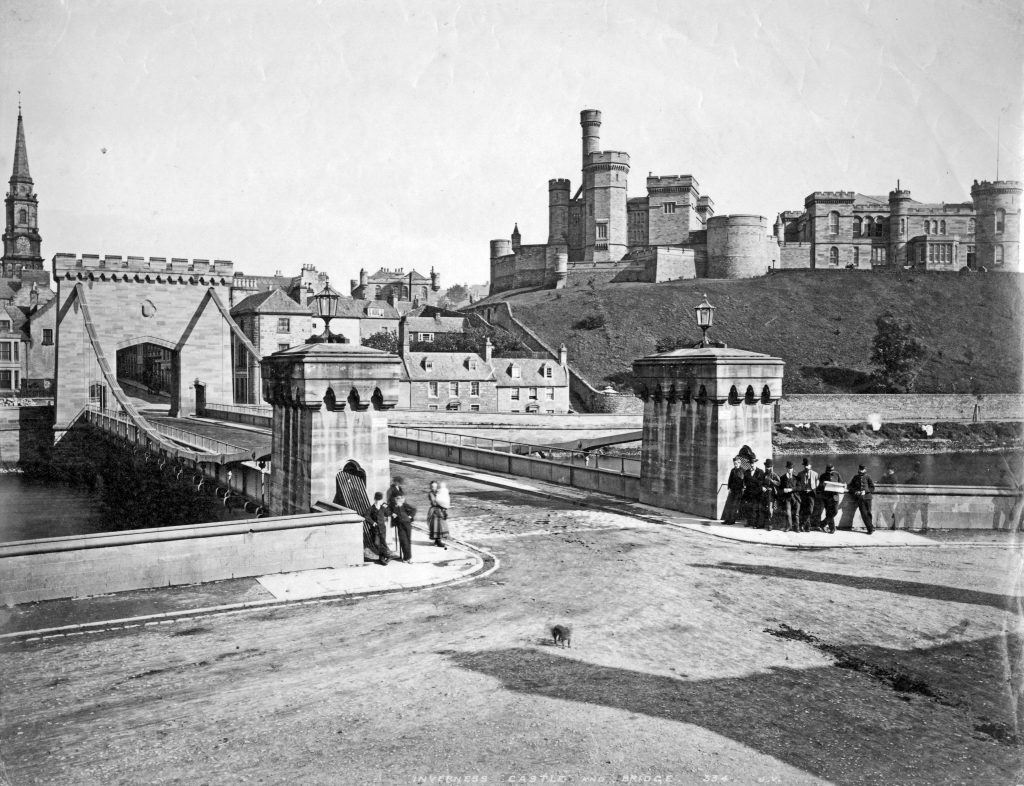
The legal proceedings against the five Skye crofters may have been over but the battle for land rights was not.
Further writs against the crofters of Braes were issued later in 1882. The sheriff officers attempting to serve summonses on the Braes crofters were again deforced on the 2nd September and the 24th October 1882, despite being accompanied on the second occasion by eleven policemen. The Braes dispute was settled at the end of 1882, with the crofters’ fines having been paid by supporters. Lord Macdonald agreed to a compromise and the people once again turned their stock on to Ben Lee.
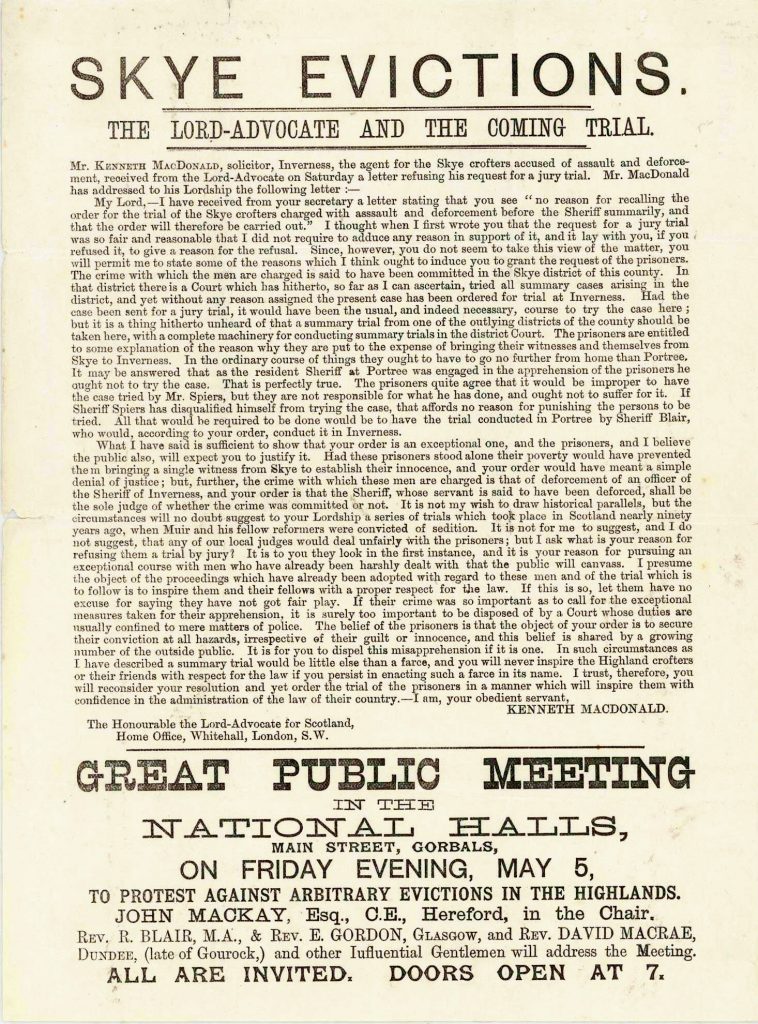
Ultimately, the crofters viewed the Battle of the Braes as a victory: Ben Lee was returned to them, although they had to pay £74.15s for what had previously been included in their rent. More importantly, though, it was the first time that both the local and national governments were forced to address the crofters’ discontent. Although the Battle did not directly lead to the introduction of legislation to protect the rights of crofters, it was a significant factor in the appointment of the Royal Commission of Inquiry into the Conditions of the Crofters and Cottars in the Highlands and Islands of Scotland, more commonly known as the “Napier Commission”.
